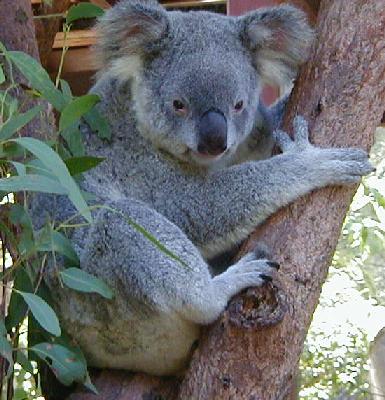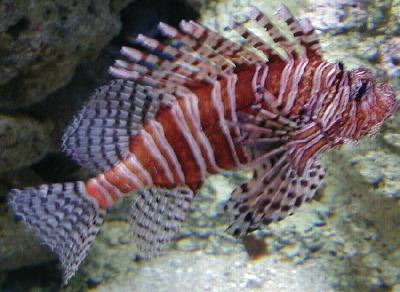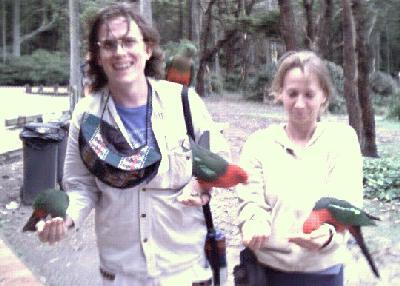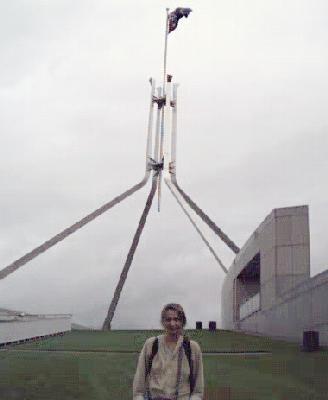
Australia part two
Echuca, Sydney, Canberra
25th February - 25th March 2000

Everybody's favourite Australian
From Kyneton, we left our most excellent hosts Jen and Carl Nielsen, and made our way to Echuca, on the River Murray. Veronika had watched a couple of films made and set in Echuca at the turn of the century, so had a little bit of an idea of what to expect, but I didn't. The main reason for going was that Veronika's cousin Zdenka and her husband Norm live in Moama, which is the twin city of Echuca on the other side of the river (and also on the other side of the border, back in New South Wales). We had a bit of trouble getting to Echuca, as in Victoria the government-owned V-Line appear to have a monopoly on bus travel within the state, making it difficult to say the least. McAfferty's were willing to drive us to Moama, but would not sell us a ticket to Echuca. I cut through the bureaucratic nonsense by buying a ticket to Moama (for the same price) and arranging to get off at Echuca. Unfortunately the bus driver was reluctant to do this, but in the end agreed to let us off at Echuca as long as we got off quickly and non-demonstratively, and not to tell anyone that we had done so.
We were met off the bus by Zdenka, cousin of Veronika's father. All the other Soucek relatives we'd met said that Veronika reminded them of Zdenka, but I must confess that beyond the typical Soucek youthfulness of appearance, I didn't spot the resemblance. However, we had seen some old photos of Zdenka when she was a girl, and the similarities are obvious.
Zdenka took us for a brief tour of Echuca, having first waited while we checked into our hostel and dropped off our luggage. We stayed at the YHA in Echuca, a very pleasant and friendly little place which we had almost to ourselves (quiet season, apparently). We actually slept in a tent, but we were not in any real sense camping - the tent had a (proper) double bed and an electric fan, which was just as well, since Echuca lived up to its reputation for humid heat, becoming particularly oppressive on our last day in the town.
After checking in to the hostel, we went to Zdenka's house in Moama, where we had a very pleasant lunch and a chat before heading back to Echuca. We then explored the town a little, not a very taxing task as it's not exactly a major city. We had dinner again at Norm and Zdenka's and then returned to our hostel to rest.

Veronika showing how it's done
The following day we took a short trip on a river boat (Echuca being home to the world's largest collection of working paddle steamers) along the River Murray. Again the weather was very hot, and the humidity was so powerful you felt that it was going to rain at any moment, but fortunately it couldn't quite bring itself to pour down. The boat we were on had actually spent 25 years at the bottom of the river before being dragged out, lovingly restored, and brought back into service to cater for the tourist boom precipitated by the success (at least within Australia) of the film "All the Rivers Run". The old port, which had been restored to its original form for the film, was retained as a tourist attraction, and although fairly small it is done pretty well. Particularly impressive was the wharf, which was originally over a mile long, but not all of it has survived the decline of the Murray as the main highway into the eastern interior. Still, what remains is an impressive complex structure made entirely of gum wood (except for the nails of course). One item of interest to genealogists was a boat docked at the wharf, which bore a small cross on the roof. This was the boat used by a travelling minister to travel upriver to the isolated farms further upstream for "hatches, matches and dispatches". Often a small place might go several years without seeing a minister, and so group baptisms were fairly common, and they followed the old Scots tradition of legitimising children of parents who subsequently married. Then again, out in the "back of Bourke", as they say down under, I don't suppose anyone really worried about that.
Zdenka's daughter Betty owns a little souvenir shop in Echuca called the Dancing Emu. It is full of interesting albeit slightly touristy souvenirs, and the name comes from a performance that Betty puts on (and does very well) involving line-dancing emu puppets - it has to be seen to be believed, and although it sounds tacky, it is extremely entertaining. While we were visiting the shop, an aboriginal man came in to the shop to sell Betty some hand-crafted dijeridus. Unlike many of the dijeridus sold to tourists, which are often cheap wood, largely non-functional as a musical instrument, and frequently made by non-Aborigines, these were the genuine article - the insides had been hollowed out by ants, not just carved out using metal tools, and the symbolic paintings on the outside were actually representative of the man's home area, not just pretty pictures produced to please the tourist hordes. Needless to say, the dijeridus were priced to match, so we had to be satisfied with attempts to play them, attempts which in my case were hopeless failures, but in Veronika's case were surprisingly successful.

"Australian goldfish"
From Echuca we were given false information regarding the availability of buses to Sydney, so we ended up having to change buses unnecessarily at some small town which thankfully remains nameless, and were forced to wait for four hours outside the railway station. Luckily, the guy cleaning the station, which was closed, took pity on us and allowed us to wait inside, and we caught a night bus back to Sydney.
My cousin Steve Wakely picked us up from central station and very kindly took us into his home for the duration of our stay in Sydney. The main aim of our stay was for me to work so that we could generate some more cash for the rest of our trip, so we didn't do a great deal of sightseeing. We (or I should say I) did manage to pay a couple of visits to the library of the Society of Genealogists, gathering a fairly large amount of very useful information in the process.
Other than that we made a repeat visit to the aquarium, this time with a digital camera available to ensure that we got hold of some good shots. This was on the same day that we visited the Imax cinema on Darling Harbour, which promotes itself as the world's largest cinema screen. I'm fairly suspicious of such claims usually, but I'm willing to believe this one, as the screen was enormous (six storeys high, apparently). We saw a film about Sydney, which included some fantastic views of the harbour, and a 3-D film about the Galapagos islands. The latter just made me more annoyed that we were unable to visit the Galapagos while we were in South America, and also more determined to visit them at some point in the future. I must admit however that I'm still somewhat cynical about IMAX cinemas after learning that the largest attraction in terms of visitor numbers in the Grand Canyon in the US is the IMAX theatre, with many people apparently driving to the IMAX theatre to see a film about the canyon without ever actually setting eyes on the canyon itself. Hmmm.
Other than that, most of our time in Sydney was spent working or enjoying, perhaps excessively, the excellent hospitality of Steve and for a couple of nights Glennys and Keith Ferguson. The only other major attraction that we visited was the Taronga Park Zoo which, despite being in the midst of a major refurbishment in time for the Sydney Olympics which meant that a large part of it was closed off, was definitely worth a visit, although I was initially a little annoyed because the (state-owned) ferry company refused to give us a discount on the combined ferry-and-zoo tickets, even though we were entitled to a $5 discount on the entrance fee to the zoo. This is a common occurrence in Australia - Ozzies get discounts when they travel overseas, but they're very reluctant (to say the least) to reciprocate. Then again, pensioner discounts often don't apply to pensioners from other states within Australia, so I can't really complain of anti-foreigner discrimination, unless, as no doubt some people here do, you consider a Victorian a foreigner in New South Wales.

The most beautiful animal in the world?
Sydney Zoo as you would expect is home to a large number of Australian animals, although it also houses a considerable number of foreign species as well. It's a good zoo, but perhaps not fantastic (except for the setting, and my judgement may have been coloured by the fact that every second enclosure just about seemed to be closed for renovations). Veronika however, not being as jaded and cynical as myself, was thrilled - she had never seen elephants and giraffes (to name but two) before, except on TV. The highlights for me were the monitors (similar to large lizards), the stunning Sumatran tiger (the most beautiful animal in the world? It's got my vote) and the red panda - an animal I'd never even heard of until we saw one at the zoo.
Before going to the zoo we visited the Travellers Medical and Vaccination Centre, where we bought some more anti-malaria pills and received our final vaccinations before we head towards Asia.
For our further travels around Australia, we opted for a bus company by the name of the Oz Experience. They offer a pass from Sydney to Darwin with many interesting stops along the way and unlimited stopovers over a period of six months. They take roundabout routes to their destinations, not worrying about finding the quickest and shortest way, unlike the other companies. In addition, they can book accommodation for you and make stops each day at interesting points. While companies like Greyhound and McAfferty's also stop, it's usually at such interesting Ozzie highlight as bus stations and roadside service stations (such as the legendary Giant Merino, which as the name suggests, is home to a huuuge stone sheep), and when they stop for meals, they usually do so at a place where the only option is an expensive dodgy diner - I'm sure they get a cut for bringing in so many clients.

Feeding the birds on Pebbly Beach
Our first trip with Oz Ex was from Sydney to Canberra. We needed to sort out some visas for our further trips beyond Australia, and so we had to come to Canberra. Also, the city had been recommended to us by several people. However, in common with a lot of cities in the US, Canberra, a completely planned city, is obviously not built for pedestrians. They make a token gesture towards pedestrianism by providing a couple of pedestrian precincts for shopping, but when we tried to find our way from the Indian embassy to the parliament building, we had to negotiate four-lane motorways with no pavements (a common feature of Australian cities - you either walk on the road or feel like you're trespassing on someone else's property by walking on the grass, or "nature strips" to use the correct Ozzie term) or even traffic lights. At least Canberra appears to be reasonably well served by public transport, unlike Sydney, where some areas of the city have no public transport at all.
On our way to Canberra, we made a number of stops during the day. After leaving the city, our first stop was at Kiama for the "world famous in Australia" (??) blowhole, which normally blows up to sixty metres, or at least that's what the brochures say. Despite being a wet and blustery day, I don't think it blew as much as sixty millimetres while we were there. There is however a fine view along the shore, although it was too wet and cold to really appreciate this, especially as we were dressed in shorts and t-shirts.

Boxing, Ozzie style
Lunch stop was in Uladulla, from where we made our way to Pebbly Beach. This had been recommended to us by Glennys and Keith as a choice spot, and we were not disappointed. The forest comes right up to the beach, as do a friendly bunch of eastern grey kangaroos, who happily let you stroke them and are willing often to pose for photographs, even mothers nursing their young. As a finale, they offer a sporting contest by boxing with each other, tipping their heads back to protect their eyes. We'd seen kangaroos in zoos and wildlife reserves before, but not up close and personal. I can safely say that they have vicious-looking claws, and I wouldn't want to get on the wrong side of them, but I was very pleased to see them. On the way back to the bus we played with the birds, beautiful, outrageously colourful lorrikeets, king parrots and others, who were happy to get a free feed from us. We hung around taking pictures and getting scratched but not minding. I'd done the same thing with pigeons in Krakow a number of years ago, but this was a bit more spectacular, and the birds were kind enough to avoid crapping on our heads.
From Pebbly Beach we headed inland to Canberra, where we were planning to stay for a week to sort out some visas and for me to do some work, which I had been warned to expect. Fortunately, I managed to find a place (conveniently in the same building as our hotel) which was willing to let me use my floppy to download a file, so we were set.
Our first day in Canberra, we went to the Indonesian embassy, where the very friendly and pleasant man at the consulate was more than happy to help us arrange a visa. Not for the first time, I don't need a visa as I have a British passport, but Veronika needs one (and it's not cheap - A$125, or about 50 pounds/150 Deutsche marks!). We also need to have an onward ticket, which could prove quite a problem, but we'll figure it out. From the Indonesian embassy we went to the Indian embassy to find out about the visa requirements there. It turned out that the receptionist's father was from Koper in Slovenia - small world etc. We need a week to get an Indian visa, so we'll have to sort that out in Melbourne. From there we had a big problem negotiating the many concentric ring roads which in Canberra pass for a traffic system before eventually reaching the parliament building, our destination.

The aboriginal embassy in Canberra
We took advantage of the free tour to wander around, discovering in the process that the British government had spent a large amount of money gifting a luxury chair to the parliament which has never been used, as it's reserved for the queen and she's never yet opened the Ozzie parliament - typical quality spending control by the UK. The parliament is opulent in a modern, ridiculously expensive sort of way, although I must confess that I don't see how they could possibly have spent A$ 1.2 billion (in 1988!) without large amounts of money disappearing down a large black hole - maybe the offices are stunning, or more likely some contractors made a killing and some politicians are sitting on some lovely little Swiss bank accounts. Much of the building is actually underground, built into the side of a hill, so perhaps that explains the exorbitant cost. Certainly one Ozzie visitor seemed determined to point out to the guide the ridiculous expense and waste-of-time nature of the whole project (Australians are if anything even more cynical and politician-weary than the British). On federation in 1901, Australia didn't have a capital, and both Sydney and Melbourne vied for the title. Having failed to agree on a choice, they picked an empty piece of land (empty that is, except for the aboriginals living there) and declared it to be the capital. After organising a competition, an American design was chosen for the planned city and work proceeded at a snail's pace to this very day. It's still not finished, although most of the work is.
Other activities in Canberra included a trip to the National Library, where inevitably perhaps I did some family-history research, much to Veronika's enthralment. We also visited the National Botanical Gardens, built on a hill on the other side of the Australian National Library, where we saw our first kangaroo paws (the plants, that is, not the, well, paws), as well as many of the 600+ types of gum tree (eucalyptus) native to Australia and several varieties of banksia, by far and away my favourite Australian flower, being so different from the flowers that I'm used to.

Someone's got a burst pipe ...
Another thing we saw was the Captain Cook memorial, which consists of a hollow globe charting the routes taken by Cook on his exploratory voyages and a to my mind rather pointless "fountain" - actually a high-powered jet of water shooting maybe 60 metres into the air - perhaps this is where the Kiama blowhole disappeared!
We also visited the vast Australian National War Memorial. This is a very impressive place, a fitting tribute to the thousands of Australians who have given their lives for their country, or often enough for another country altogether (i.e. Britain). The focus of the memorial is the tomb of the unknown Australian soldier from the first world war, whose remains were discovered by a farmer in Belgium and returned for reinterment in Australia in 1993. In addition to the usual wall plaques listing the names of those who died, the memorial also houses a large museum (like the parliament house, built largely underground) showcasing artefacts and displays from the various wars in which Australians have fought. One personal highlight was the decoratively carved rifles used by an Ozzie relative of mine, Harold Grafton Carstairs, during the Boer war. The memorial is also home to an excellent computer-based research centre for those interested in the military records of their relatives who fought for Australia. These go all the way up to the Vietnam war, a conflict in which the Australians, persuaded by the Americans, were unfortunate enough to become embroiled in.

They spent so much money, they can't afford a roof ...
The only other thing about Canberra I would like to mention is that, perhaps not surprisingly given the Sydney water scare of a few years ago, the water in Canberra tastes much better than the water in Sydney.
Previous | Next | Travel index | Family history | Romany | Main index | Mail me